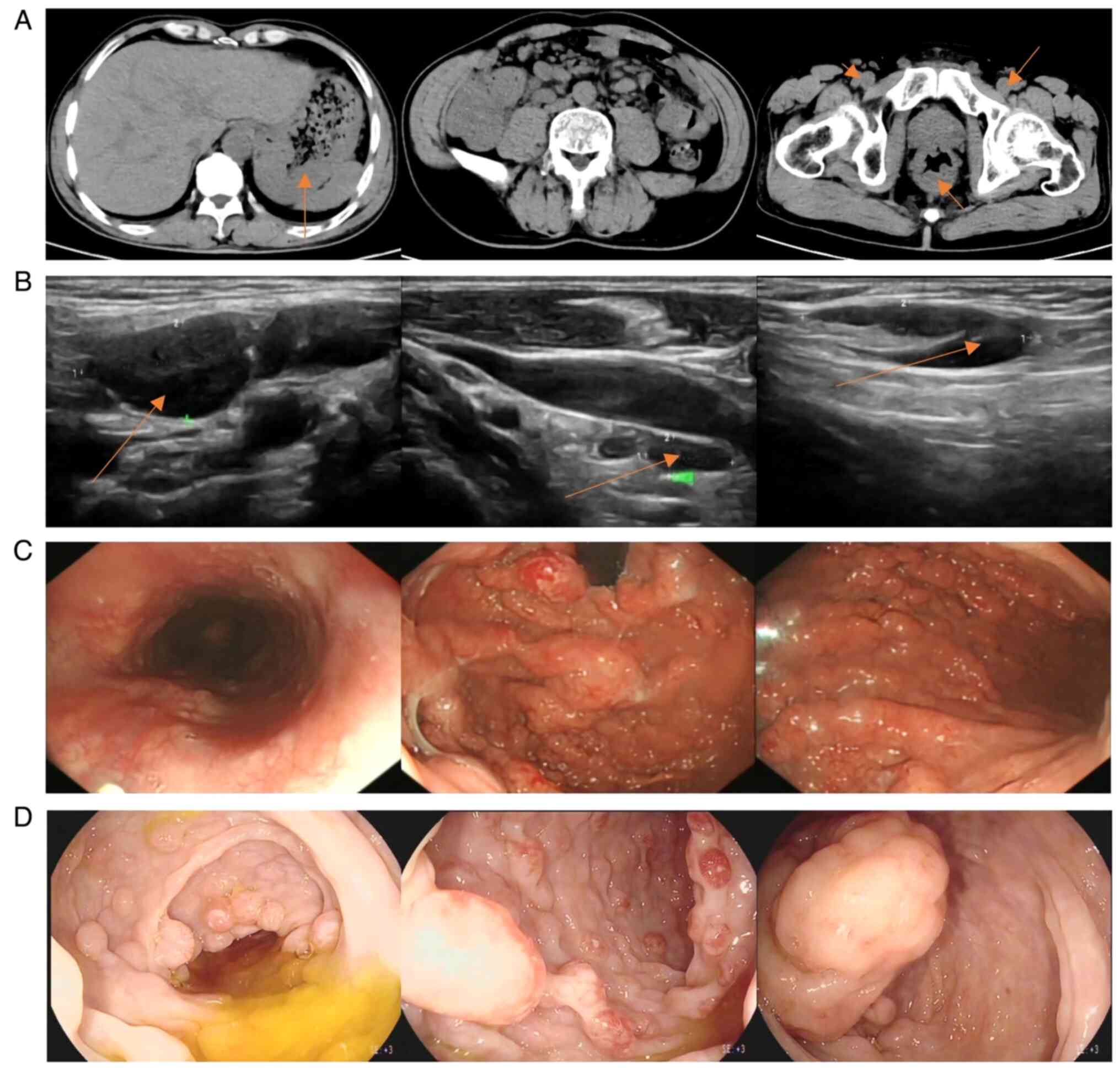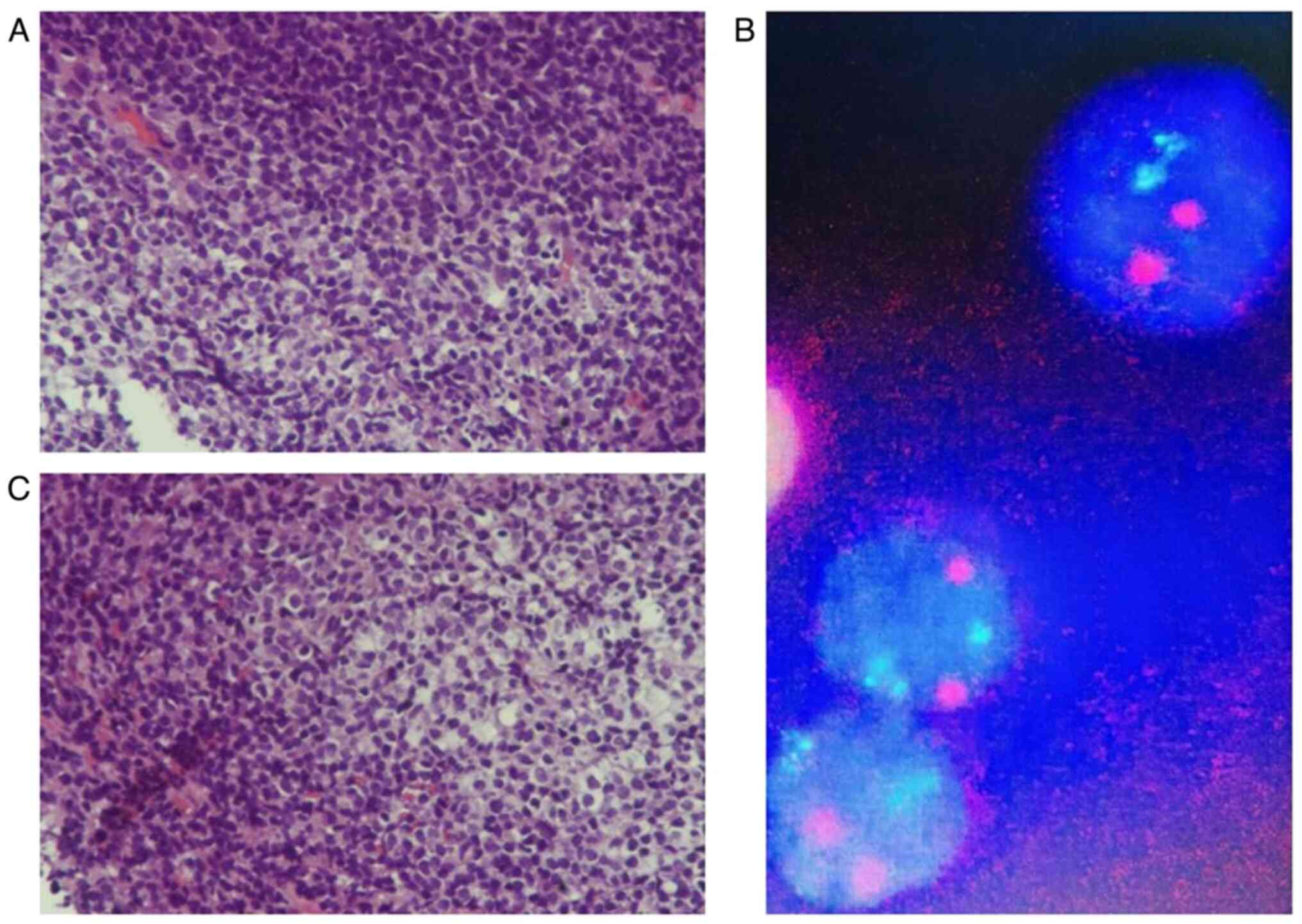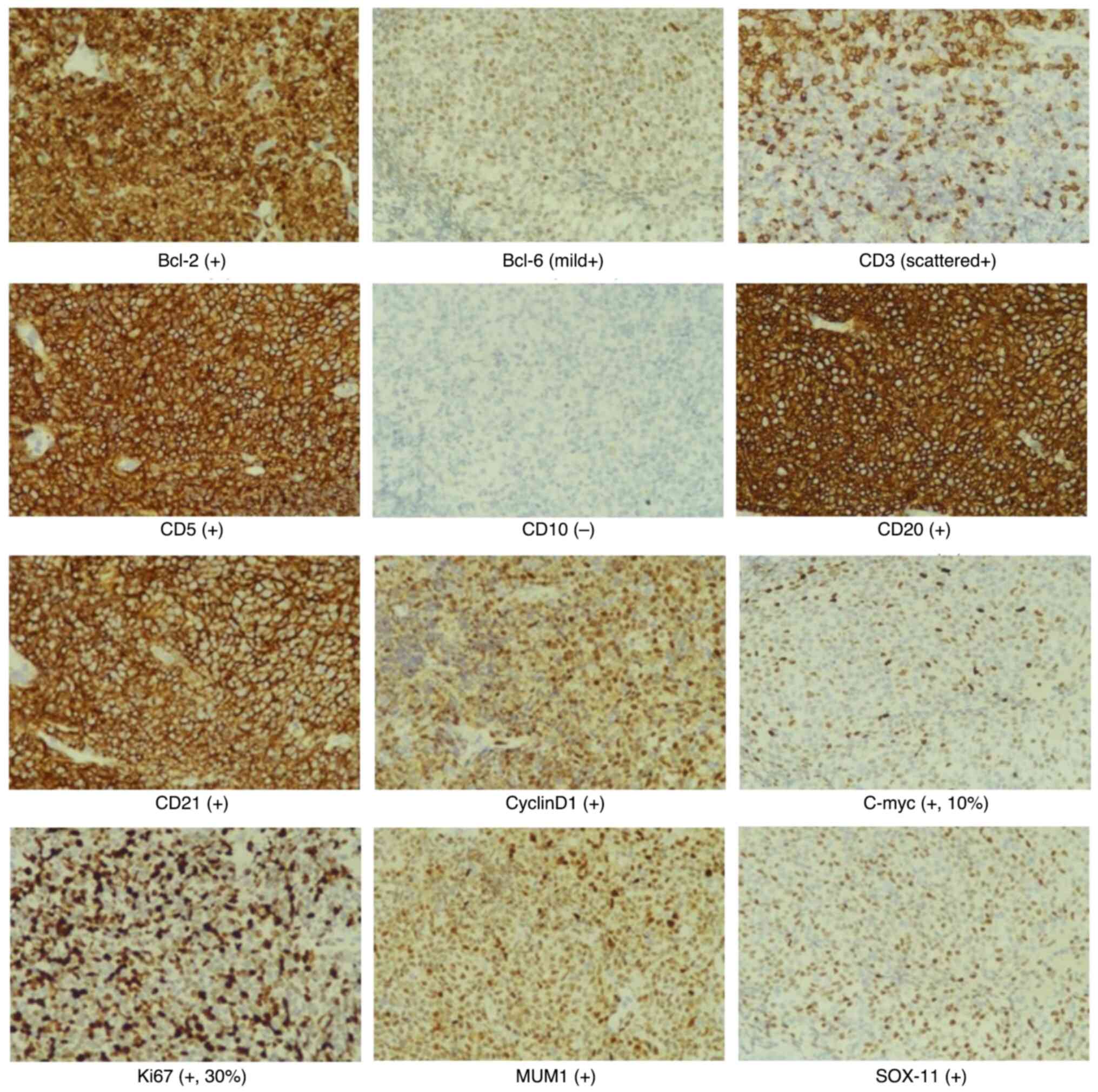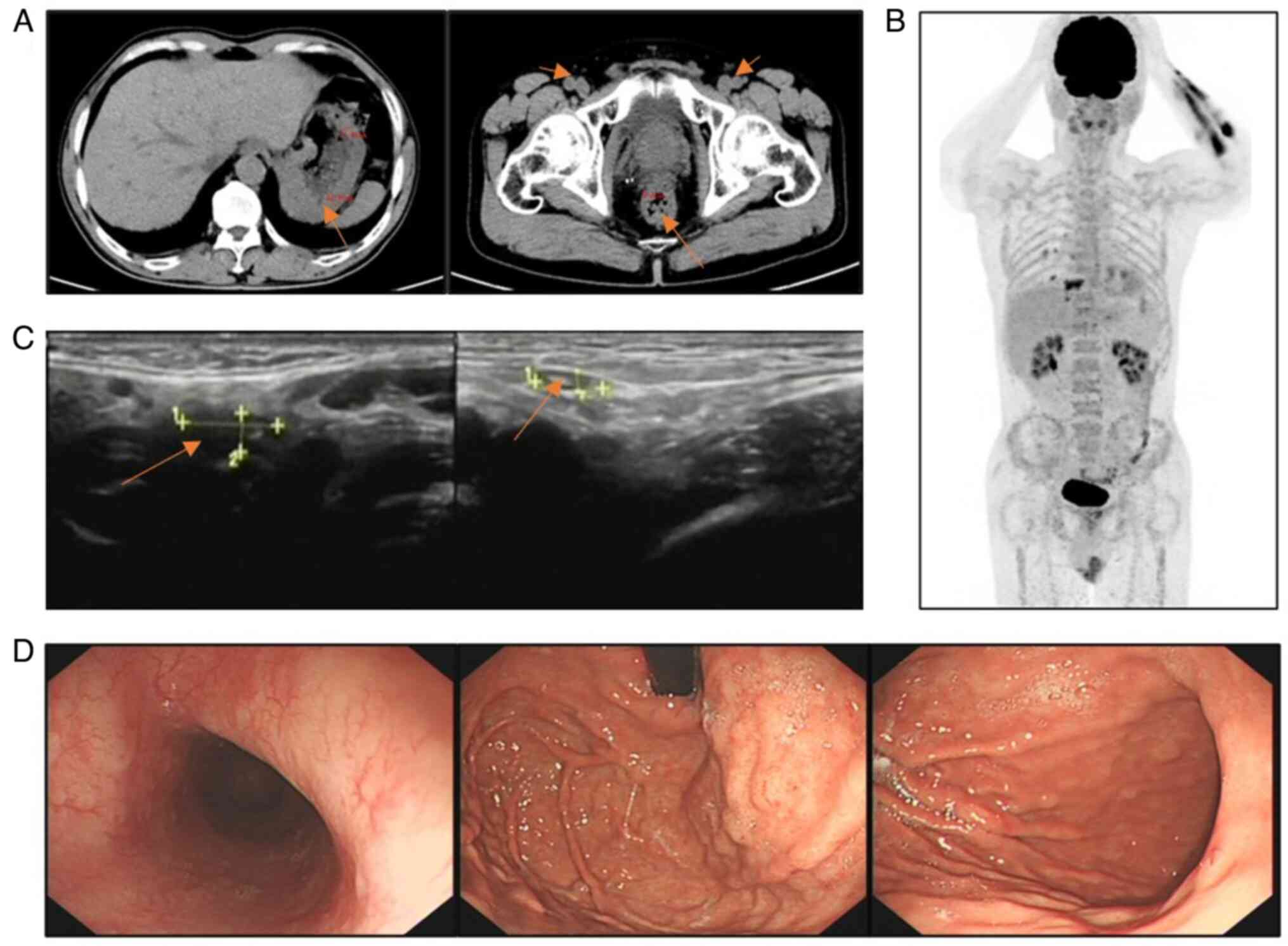Mantle cell lymphoma characterized by numerous diffuse polypoid lesions along the entire digestive tract: A case report
- Authors:
- Published online on: June 7, 2024 https://doi.org/10.3892/ol.2024.14496
- Article Number: 363
-
Copyright: © Cheng et al. This is an open access article distributed under the terms of Creative Commons Attribution License.
Abstract
Introduction
Mantle cell lymphoma (MCL) is a subtype of B-cell non-Hodgkin lymphoma (NHL) that accounts for 3–10% of NHL cases, typically involving the lymph nodes (1). The majority of patients with MCL are diagnosed at an advanced stage, with bone marrow involvement and lymph node spread (1,2). The gastrointestinal tract is impacted in 15–30% of patients with MCL (1,3). Primary MCL in the gastrointestinal tract is rare, accounting for 4–9% of all reported cases of gastrointestinal NHL (1) Primary gastrointestinal tract MCL is also referred to as lymphomatous polyposis and it typically manifests as single or multiple polypoid lesions, ulcerative lesions or thickening of the gastrointestinal wall (1,3). Most commonly the stomach and ileocecal regions are affected but any part of the gastrointestinal tract can be involved (3,4); however, complete involvement of the gastrointestinal tract in MCL is rare (5). In the present report, a case of MCL that manifested as numerous diffuse polypoid lesions along the entirety of the digestive tract is described.
Case report
A previously healthy 56-year-old male patient was admitted to the Department of Gastroenterology of Hunan Provincial People's Hospital (Changsha, China) in August 2023 with abdominal pain that had lasted for >6 months and had worsened over the past month. The patient complained of upper abdominal distension and pain accompanied by acid reflux, especially at night, with occasional diarrhea. No other symptoms of discomfort were reported. Since the onset of symptoms, the patient had a poor mental state and sleep quality, moderate appetite, changes in bowel movements (low fecal volume and difficulty in defecation), normal urination, and no significant change in weight. The patient denied any familial genetic history of malignant tumors of the digestive tract, and their spouse and child were healthy.
At admission, the body temperature of the patient was 36.4°C, the heart rate was 80 bpm and the blood pressure was 134/80 mmHg. Physical examination revealed mild tenderness of the upper abdomen and superficial lymph node enlargement in the neck, subclavian region and groin. Based on the clinical symptoms alone, the patient could easily be diagnosed with chronic gastritis. CT (Fig. 1A) showed multiple thickenings of the gastric and intestinal walls and numerous enlarged lymph nodes throughout the body. Superficial lymph node ultrasonography (Fig. 1B) revealed enlarged lymph nodes in the bilateral neck, upper and lower clavicle areas, armpits, groin and abdominal cavity. Gastroscopy (Fig. 1C) showed numerous wide basal and circular polypoid lesions in the entire gastric cavity, duodenal bulb and descending part, with rich vascular networks on the surface and a hard texture. Colonoscopy (Fig. 1D) revealed that the ileocecal valve was swollen and uneven, and the valve opening was not visible. The entire tract was covered with wide basal round or spindle-shaped polypoid lesions with a size of 0.5–1.5 cm. The surfaces of the polypoid lesions were rich in vascular networks, and a portion of the lesions were internally erosive, fragile and prone to bleeding. Other abnormal results included the fecal occult blood test [(+; normal value, (−); Colloidal Gold Method] and albumin level of 29.59 g/l (normal range, 35–55 g/l; Bromocresol Green Method). The white blood cell (WBC) count was 9.82×109/l (normal range, 4.00–10.00×109/l). The quantitative value of lactic dehydrogenase (LDH) was 205.4 U/l (normal range, 100.0–240.0 U/l). Based on the symptoms and examination results of the patient, lymphoma was suspected. Samples were fixed using 10% neutral buffered formalin at room temperature (20–26°C) for 24–48 h. Sections (3-µm thick) were stained with hematoxylin staining solution at room temperature for 1 min. The results (Fig. 2A and C); showed patchy lymphocyte infiltration in the mucosa, with local follicular structures. Fluorescence in situ hybridization (FISH; Fig. 2B) indicated that the lesion was CCND1/IGH (−), and immunohistochemical staining (Fig. 3) indicated that the lesion was CD21 (+), CD20 (+), Ki67 (+; 30%), Bcl-2 (+), Bcl-6 (mild+), CD5 (+), CyclinD1 (+) and SOX-11 (+). Therefore, the patient was diagnosed with MCL stage IV and scheduled to be transferred to the Department of Hematology of Hunan Provincial People's Hospital for chemotherapy. After completing tumor assessment, the patient received rituximab in combination with cyclophosphamide, doxorubicin, vincristine and prednisone chemotherapy (R-CHOP). After two cycles of R-CHOP (Table I), a CT scan (Fig. 4A) showed a marked reduction in lymph nodes in multiple areas and less thickening of the gastrointestinal wall compared with previous scans, but did not demonstrate complete response (CR) because there were still abnormalities. Treatment was changed to rituximab combined with etoposide, oxaliplatin and ifosfamide, with the addition of ibrutinib capsules (Table I). After completion of cycle 6 of the treatment, the patient underwent superficial lymph node ultrasonography, gastroscopy and positron emission tomography (PET)-CT in February 2024. The PET-CT scan (Fig. 4B) showed no significant hypermetabolic lesions in the gastrointestinal wall and the lymph nodes throughout the body. The superficial lymph node ultrasonography (Fig. 4C) did not reveal obvious lymph node enlargement. The gastroscopy (Fig. 4D) indicated that the polypoid lesions in the stomach had virtually disappeared. These results showed that the patient had achieved CR. The patient was followed up every 21 days with the medical record system of the hospital.
Discussion
MCL is a rare aggressive lymphoma with poor prognosis (6). Classical MCL accumulates in the lymph nodes, spleen and extranodal sites, including the gastrointestinal tract (7); however, MCL is rarely diagnosed in the gastroenterology department, as MCL belongs to the category of hematological malignancies. MCL commonly harbors chromosomal translocations, such as the t(11;14)(q13;q32) translocation involving the IGH and CCND1 genes (6). The pathogenesis of MCL includes Cyclin D1 expression upregulation, SOX-11 expression upregulation, TP53 mutations and other molecular alterations such as chromosomal complexity and NSD2 (7).
The clinical symptoms of patients with MCL are not specific. Some patients have no symptoms, but present with lymph node, spleen and bone marrow involvement (1). Clinical presentations of gastrointestinal tract MCL rarely have typical characteristics; however, abdominal pain, distension, diarrhea, melena and hematochezia may occur (3,4). The clinical presentation in the present case was chronic abdominal pain with occasional diarrhea but no other discomfort was reported. Without digestive endoscopy, gastroenterologists may misdiagnose the patient as having chronic gastritis, and MCL can easily be missed.
MCL of the gastrointestinal tract often occurs in the stomach and ileocecal regions (3). During endoscopic examination in the present case, it was found that the lesions were present along the entire digestive tract, including the stomach and colon. Endoscopic findings included multiple polypoid masses of different sizes with smooth surfaces. As these findings are similar to those of polyps, it is easy for physicians without endoscopic experience to diagnose endoscopic findings as hereditary polyposis, and thus, delay treatment.
The patient was diagnosed on the basis of digestive endoscopy and pathological evidence. Therefore, timely histopathological and immunohistochemical staining after endoscopic examination was key to distinguishing it from other diseases (4,8). The pathological and immunohistochemical specimens were polypoid tissues of the gastrointestinal tract obtained during endoscopy. Pathological examination revealed patchy lymphocyte infiltration in the mucosa and a local follicular structure. Immunohistochemical staining showed that the lesion was CyclinD1 (+) and SOX-11 (+). Based on the results of the gastrointestinal endoscopy and pathological and immunohistochemical staining, the case was confirmed as MCL (7).
Patients with MCL at different disease stages undergo different treatment strategies. PET/CT has a higher staging accuracy than conventional CT, and the patient in the present study was identified as having stage IV disease (8) on PET/CT. For patients with stage III–IV MCL, both symptomatic and asymptomatic patients with a high tumor burden should be treated as soon as a diagnosis is made, and a regimen of rituximab plus chemotherapy is generally recommended (8). After rituximab was combined with chemotherapy and ibrutinib capsule-targeted therapy, endoscopy indicated that the polypoid lesions were markedly reduced or even disappeared, which was a significant improvement compared with the first gastroscopy. Re-examination of the PET/CT scan revealed that the patient achieved CR. In the present case, timely gastrointestinal endoscopy facilitated immediate treatment after diagnosis, resulting in highly effective therapeutic outcomes.
The prognosis of MCL is related to numerous factors, such as stage, risk factors, gene mutations and chromosome translocations (7). The International Prognostic Index of MCL (MIPI) includes age, Eastern Cooperative Oncology Group (ECOG) performance status, lactate dehydrogenase (LDH) level and white blood cell (WBC) count at initial diagnosis (8,9). According to the MIPI, risk groups describing the prognosis of patients with MCL are divided into low-, intermediate- and high-risk groups (8,9). The present case involved a 56-year-old male patient with mild limitations in physical activity. The initial diagnosis revealed normal levels of LDH and WBC counts, indicating that the patient was in the low-risk group (9). In FISH, no abnormalities were detected in the IGH and CCND1 genes, which may indicate that these two genes did not undergo the expected mutations in this specific case. Therefore, the patient had a favorable prognosis.
Infectious and immunological factors are considered to be involved in the pathogenesis of lymphomas. Poor living habits, including smoking and drinking, and hepatitis B and Epstein-Barr virus infection can increase the risk of NHL (10,11). Furthermore, chronic hepatitis C infection may be related to the occurrence of lymphoma, and direct-acting antiviral therapy can improve the cure rate (12,13). Therefore, prevention of viral infections, good living habits, long-term moderate physical exercise and regular health examinations can reduce the incidence of lymphoma to a certain extent (10).
In conclusion, endoscopy is necessary for patients with gastrointestinal symptoms. Early endoscopy can improve the detection and diagnosis of MCL, and obtaining histological specimens can also help diagnose MCL as soon as possible and evaluate effective early treatment options so that patients can achieve the goal of a CR.
Acknowledgements
Not applicable.
Funding
Funding: No funding was received.
Availability of data and materials
The data generated in the present study may be requested from the corresponding author.
Authors' contributions
SC and LY conceived and designed the study. LY and XW obtained the data. SC and LY analyzed the data and drafted the manuscript. SC and LY confirm the authenticity of all raw data. SC and LY revised the manuscript prior to submission. All authors read and approved the final version of the manuscript.
Ethics approval and consent to participate
Not applicable.
Patient consent for publication
Written informed patient consent was obtained to publish the article.
Competing interests
The authors declare that they have no competing interests.
References
|
Castellino A, Tun AM, Wang Y, Habermann TM, King RL, Ristow KM, Cerhan JR, Inwards DJ, Paludo J, Ansell SM, et al: Clinical characteristics and outcomes of primary versus secondary gastrointestinal mantle cell lymphoma. Blood Cancer J. 11:82021. View Article : Google Scholar : PubMed/NCBI | |
|
Lamm W, Dolak W, Kiesewetter B, Simonitsch-Klupp I, Puhr H and Raderer M: Gastrointestinal involvement in patients with mantle cell lymphoma: A single center experience of eighty-five patients. Dig Dis. 37:194–200. 2019. View Article : Google Scholar : PubMed/NCBI | |
|
Mohy-Ud-Din N, Guha A and Mitre M: Complete endoscopic and histopathological remission of mantle cell lymphoma of the gastrointestinal tract. Cureus. 11:e43502019.PubMed/NCBI | |
|
Zheng QF, Li JY, Qin L, Wei HM, Cai LY and Nong B: Gastrointestinal involvement by mantle cell lymphoma identified by biopsy performed during endoscopy: A case report. Medicine (Baltimore). 97:e97992018. View Article : Google Scholar : PubMed/NCBI | |
|
Huang PJ, Chang CL and Suk FM: Polypoid lesions from the oesophagus to colon. Gut. 67:5522018. View Article : Google Scholar : PubMed/NCBI | |
|
Maddocks K: Update on mantle cell lymphoma. Blood. 132:1647–1656. 2018. View Article : Google Scholar : PubMed/NCBI | |
|
Jain P and Wang M: Mantle cell lymphoma: 2019 update on the diagnosis, pathogenesis, prognostication, and management. Am J Hematol. 94:710–725. 2019. View Article : Google Scholar : PubMed/NCBI | |
|
Dreyling M, Campo E, Hermine O, Jerkeman M, Le Gouill S, Rule S, Shpilberg O, Walewski J and Ladetto M; ESMO Guidelines Committee, : Newly diagnosed and relapsed mantle cell lymphoma: ESMO Clinical Practice Guidelines for diagnosis, treatment and follow-up. Ann Oncol. 28 (Suppl 4):iv62–iv71. 2017. View Article : Google Scholar : PubMed/NCBI | |
|
Eyre TA, Bishton MJ, McCulloch R, O'Reilly M, Sanderson R, Menon G, Iyengar S, Lewis D, Lambert J, Linton KM, et al: Diagnosis and management of mantle cell lymphoma: A British Society for Haematology Guideline. Br J Haematol. 204:108–126. 2024. View Article : Google Scholar : PubMed/NCBI | |
|
Liu FD, Li XP, Xu XQ, Yu H, Luo PF and Zhou JY: Disease burden of non-Hodgkin lymphoma in Jiangsu Province from 1990 to 2019. Pract Prev Med. 30:284–287. 2023.(In Chinese). | |
|
Feng J, Fei Y, Gao M, Meng X, Zeng D, Zuo D, Ye H, Liang Y, Sun X, Liang R, et al: Treatment patterns, clinical outcomes and gene mutation characteristics of hepatitis B virus-associated mantle cell lymphoma. Hematol Oncol. 42:e32682024. View Article : Google Scholar : PubMed/NCBI | |
|
Mihăilă RG: Hepatitis C virus-Associated B cell non-Hodgkin's lymphoma. World J Gastroenterol. 22:6214–6223. 2016. View Article : Google Scholar : PubMed/NCBI | |
|
Mazzaro C, Bomben R, Gragnani L, Visentini M, Pozzato G, Pozzo F, Zucchetto A and Gattei V: Hepatitis C virus-associated B-cell lymphomas: The importance of the new direct antiviral agent therapy. Semin Hematol. 59:177–182. 2022. View Article : Google Scholar : PubMed/NCBI |













